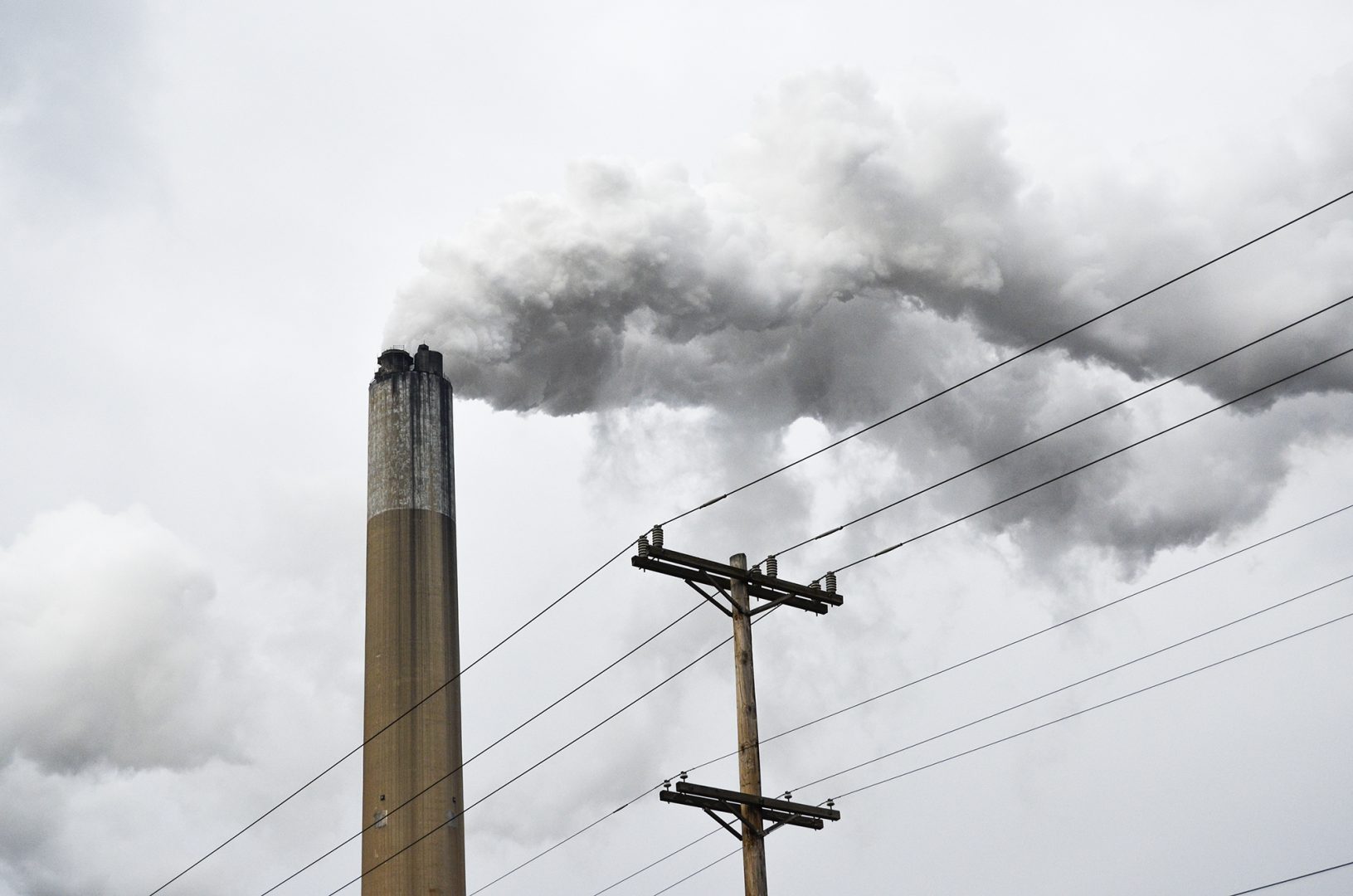
The Bruce Mansfield Power Plant burns coal to generate electricity in Beaver County.
Amy Sisk / StateImpact Pennsylvania


The Bruce Mansfield Power Plant burns coal to generate electricity in Beaver County.
Amy Sisk / StateImpact Pennsylvania

Amy Sisk / StateImpact Pennsylvania
The Bruce Mansfield Power Plant burns coal to generate electricity in Beaver County.

Marie Cusick/ StateImpact Pennsylvania
Panda Liberty Power Plant in Wysox, Pa.
Seven and a half years ago, then-Gov. Chris Christie pulled New Jersey out of a regional cap-and-trade effort to lower greenhouse gas emissions.
On Friday, state environmental regulators will hear the public’s views on two proposals that would allow New Jersey back in.
The Regional Greenhouse Gas Initiative — known as “RGGI” — puts a cap on a participating state’s carbon emissions from fossil fuel-fired electric power plants with a capacity of 25 megawatts or greater.
Power plants are given CO2 allowances, each equal to one ton of carbon dioxide. They can buy additional allowances through auctions — the “trade” part of “cap-and-trade” — and the proceeds from those auctions are used by participating states to fund things such as energy-efficiency programs, renewable energy, and other climate-related initiatives.
New Jersey’s assistant commissioner for air quality, energy and sustainability, Paul Baldauf, said climate change made rejoining the Regional Greenhouse Gas Initiative (RGGI) a priority.
“We can’t just put our head in the sand and move forward,” he said. “We need to be able to get back into RGGI so that we can have an effect on greenhouse-gas reduction over the next 10 years and going further.”
The comment period ends Feb. 15, and state officials hope to have a final rule in place by May 2019.
Nine states are part of RGGI: Maine, New Hampshire, Vermont, Massachusetts, Connecticut, New York, Rhode Island, Delaware, and Maryland.
Pennsylvania is not, nor does it intend to be, according the its Department of Environmental Protection. Yet according to the state’s Greenhouse Gas Inventory, electric-power generation accounts for the biggest share of Pennsylvania’s emissions — more than 100 million tons of carbon per year.
Environment New Jersey president Doug O’Malley welcomes New Jersey’s reentry into the program.
“You’re finally putting a thumb on the scale and putting a price on carbon that’s being emitted from fossil-fuel power plants,” he said. “You’re creating a market to reduce that pollution, and creating a revenue stream to invest in clean, renewable energy solutions.”
The proposals will be discussed Friday at an open hearing, and when it comes to the specifics, O’Malley has reservations. The Department of Environmental Protection is proposing a cap of 18 million tons of carbon in 2020, eventually dropping the cap to 12.6 million by 2030.
The power plants that would be regulated under the proposal currently emit 20.5 million tons of carbon per year. O’Malley said the 18 million-ton cap is too close to what the state is already emitting.
“We want a cap that’s way below our current emissions to create an even stronger market incentive for power plants to reduce their pollution,” he said. “We need New Jersey to not only be back in the program but to lead the charge and make RGGI even more stringent.”
His group and others have proposed starting at a 12 million ton-per-year cap.
But many business groups oppose reentering RGGI at all. Tony Bawidamann, vice president of government affairs at the New Jersey Business and Industry Association, said the cap-and-trade program amounts to a tax on businesses that will be passed on to consumers in the form of higher energy costs.
“This makes us less competitive in the region because the ratepayer is going to be paying more and more for energy use,” Bawidamann said.
Baudalf acknowledged that energy costs will increase in the short term.
“The ratepayer impact is fairly marginal,” he said. “It’s less than a dollar per month for the average residential ratepayer. We felt that is reasonable.”
He pointed to the juggling act between reducing emissions and being fair to consumers.
“You need to have a cap that does its job, which means it’s stringent, like all the other RGGI states have, and it drives down greenhouse gases. But in consideration, you also need a cap that is fair to the ratepayer and is not something that becomes too burdensome.”
That doesn’t assuage Bawidamann.
“It’s a costly state to live in, and this makes it even more costly,” he said.
But Jordan Stutt, carbon programs director at Acadia Center, a clean-energy research and advocacy organization with offices throughout the northeastern United States, said those fears are unfounded.
“The doomsday concerns about electricity prices and competitiveness in the region have not come true,” he said.
Emissions from power plants have dropped 51 percent from 2008, a year before the program started, to 2017, he said. Electricity prices in the region have fallen nearly 6 percent, while they have increased by nearly 9 percent in the rest of the country.
Though it’s true that emissions have dropped in the region, it’s difficult to pinpoint how much of that is due to RGGI and how much is due to other factors, such as the transition from coal to natural gas, a less-polluting fossil fuel; an economic downturn; and broad increases in energy efficiency.
A 2017 report by the Congressional Research Service found that “from a practical standpoint, the RGGI program’s contribution to directly reducing the global accumulation of [greenhouse gas] emissions in the atmosphere is arguably negligible.”
However, the report found that “the revenues generated from the emission allowance sales likely had some impact on emission levels in the region.”
In other words, the “cap” didn’t necessarily drive down emissions, but the price signal it created and the subsequent “trade” allowed for investments in technologies that did contribute somewhat to the decline.
On the flip side, a 2015 report from Duke University’s Nicholas Institute for Environmental Policy Solutions found that the region’s emissions would have been 24 percent higher without RGGI, and that RGGI accounted for about half the region’s emissions reductions from 2009 to 2015.
Stutt said regardless of its direct effects, the program is having an impact on emissions by changing long-term investment decisions.
“It’s also been significant in that it’s served as a blueprint for policies beyond this region’s power sector,” he said.
Indeed, all the RGGI states, as well as Pennsylvania, New Jersey, and Virginia, have joined in the Transportation and Climate Initiative, which addresses carbon emissions generated by the transportation sector and is based on the RGGI model. Among the participating states, transportation accounts for a quarter to more than half of all carbon emissions.
In New Jersey’s case, 16 percent of its carbon emissions come from the electricity generating sector, but about 42 percent come from transportation.
“We’ve made great strides over the years in the electric generating sector,” said Baldauf, “but transportation, that’s the big piece in the next few years that we have to address.”
StateImpact Pennsylvania is a collaboration among WITF, WHYY, and the Allegheny Front. Reporters Reid Frazier, Rachel McDevitt and Susan Phillips cover the commonwealth’s energy economy. Read their reports on this site, and hear them on public radio stations across Pennsylvania.
(listed by story count)
StateImpact Pennsylvania is a collaboration among WITF, WHYY, and the Allegheny Front. Reporters Reid Frazier, Rachel McDevitt and Susan Phillips cover the commonwealth’s energy economy. Read their reports on this site, and hear them on public radio stations across Pennsylvania.
Climate Solutions, a collaboration of news organizations, educational institutions and a theater company, uses engagement, education and storytelling to help central Pennsylvanians toward climate change literacy, resilience and adaptation. Our work will amplify how people are finding solutions to the challenges presented by a warming world.